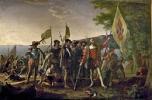
The Portuguese started trying to open a sea route to India from the beginning of the 15th century. The price of oriental goods, such as spices, was very high, and the discovery of such a trade route promised great benefits.
In 1415, the Portuguese Infant Enrique began sending expeditions along the west coast of Africa. Later he will go down in history as Henry the Navigator. Towards the end of Enrique’s life, travelers were able to reach the Gold Coast (modern Ghana). After his death in 1460, expeditions temporarily ceased, but later King Juan II continued the work of Enrique. 1488 Bartolomeu Dias expedition discovered the Cape of Good Hope - the western tip of Africa. But the expedition could not go further.
In 1492, the Spanish navigator Christopher Columbus sought to equip an expedition to the west in order to reach India. At the same time he relied on the hypothesis of the sphericity of the Earth. As a result of swimming, the foot of a European stepped on the islands of the Caribbean Sea for the first time. Columbus decided that this is the neighborhood of India, China, and Japan. In the future, he will make three more expeditions, reaching the shores of South and North America.
In the same period, the Portuguese Vasco da Gama was able to reach the real India, rounding Africa.
Chronocon is an open project. If you want to edit this map, you can write to pavel@chronocon.org and I will give an editor permission. Or you can just create copy of this map. (See documentation)


